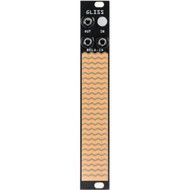Gliss - Bela
by Evan Morrow
Bela’s Gliss is not a large module, only 4HP, but there was some sizable buzz at the Bela table during Superbooth in 2023. It’s not hard to see why. A capacitive touch controller, Gliss has a myriad of uses: LFO, VCO, sequencer, modulation source, recorder, keyboard. Basically, anything you can do with control voltages, whether it’s generating them or managing them, is what Gliss can do.
With only the PCB touch surface, a light up button, an Input and two Outputs, there’s not a lot to navigate here. This doesn’t mean that Gliss isn’t deep, or that there isn’t a lot to figure out; there is, and without a doubt, you will need the manual to know all the capabilities that Gliss offers. Since it’s created on the Github open source software platform, it’s potentially forever-evolving and can be customized to suit your needs.
Multi-color LEDs illuminate the touch surface to show both placement and “pressure” when touched, and it's cool looking. In fact, Gliss is really nice looking and its simple layout, unencumbered by too many controls, which makes it great to use in real time, but a little challenging to set up or configure, since it can do so much. There’s just a lot to remember to get the most out of it, though if you’re like me and are planning on mostly set-and-forget scenarios for the most part, after initial setup you’ll only need to read the manual if you want to change things or need to re-familiarize yourself with its functionality. There are all sorts of global mode type of settings; range, brightness, modes, etc., and with no screen and just the one pushbutton, it’s left to the color of the LEDs to do the heavy lifting. Actually, the manual does the heavy lifting, but the colors and location of LEDs let you know what’s going on. One thing I noticed was that when I would be playing, my finger would obscure the LEDs from being seen. Whether this is the result of some fingers that need to lay off the pastries, or my inability to keep said fat finger from the middle of the module, if the lights are important to you, you’ll need to practice playing Gliss a bit off-center for best results.
Gliss has four Performance modes: Control, Record, Signal, and Notes. Control is maybe the most obvious mode as it outputs CV corresponding to the touch location and how much “pressure” you put on the touch strip, though “pressure” is a bit of a misnomer as instead of physical pressure Gliss determines how much skin one puts on the touch surface, and translates that into “pressure.” With location and pressure, you can use the two outputs to control both a 1V/Oct input on a VCO and the CV input (pressure) on a VCA simultaneously to get some dynamic control. You can also configure it to respond and output CV for two fingers, and latch the voltage to hold notes, or just have it be momentary. Using Gliss in this fashion, and it’s surprising just how expressive it can be. Note changes register with no perceptible lag, twitchy fingers can create beautiful vibrato, and laying a big fat finger on the touch surface can quickly open a filter or VCA all the way. It’s good fun.
The next mode is Record, and this lets you use your gestures to create and record up to seventy-five seconds of your own custom melodies, LFOs, or envelopes, and then loop, trigger, and play them back. Record mode is where my Gliss lives most of the time. I just think it’s so cool to be able to draw LFOs that change shape, time, and intensity (pressure) at my whims.
Signal Mode lets you alter CV signals by offsetting, scaling, and otherwise changing voltages. Honestly, while I like the utilitarian aspect of Signal Mode, there’s no way I can use Gliss for this. Choosing between creating custom looping LFOs/envelopes/melodies vs. offsetting an existing CV? There’s no competition. Bring me the recording gesture controller!
The final mode, Note Mode, turns Gliss into a five-note pressure sensitive keyboard. Again, while this is neat and useful, I just don’t see using it this way, unless in a pinch, and I only did so to fully test out Gliss. Even though you can customize those five notes and/or use it as a sequencer—which I do like quite a bit—and even quantize the CV output, I found the other modes (again, mostly Record Mode!) way too enticing to commit to Gliss being in Note Mode.
Even though I spent (and continue to spend) a lot of time with Gliss, without a cheat sheet, I couldn’t recall what color or position does what in each mode to configure Gliss. In no way does this limit the fun or usefulness of Gliss, and I’ve seen a few people with those little 4ms Pods and four or five Gliss modules in there for use as a mixing device or multi-channel controller, and it does look really tempting, though I'd be hard pressed to go away from Record Mode. All in all, Gliss is a great way to add some personalized performance to your setup, and I expect we'll be seeing these used in all sorts of ways.
Price: $149


